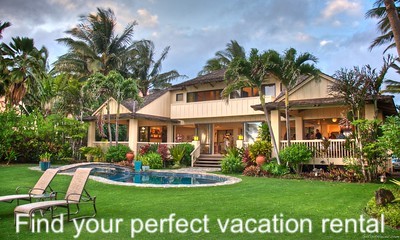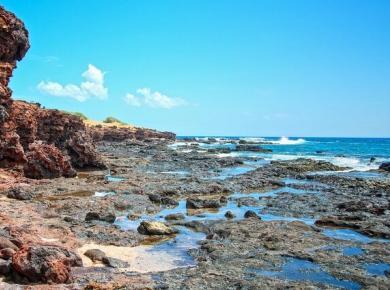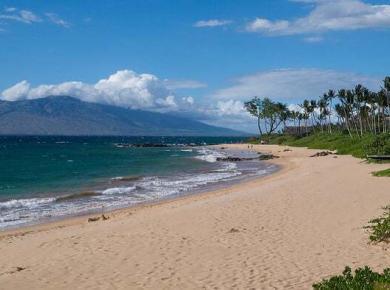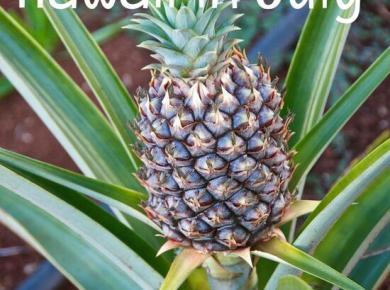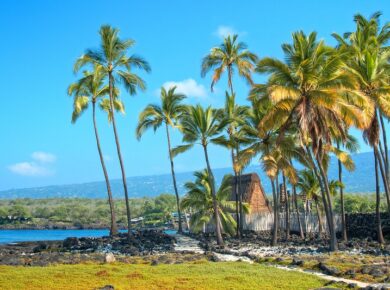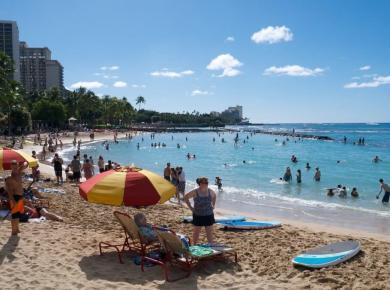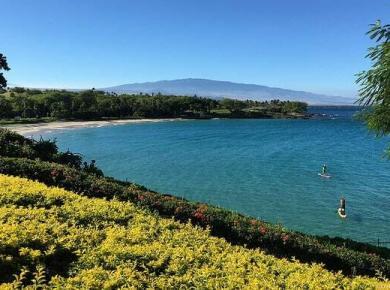When there’s so much to see and do on a Hawaii vacation, one of the last things you want to do is to get a miserable sunburn. The Hawaiian sun is strong due to its proximity to the equator. So, most folks need to take precautions to prevent sunburns. In this article, we want to share some helpful information about sunscreens along with our favorite sunscreens.

Our sunscreen selection criteria
Our sunscreen criteria aligns with what the American Academy of Dermatology Association recommends, at a minimum, which is:
- Broad-spectrum protection (protects against UVA and UVB rays)
- SPF 30 or higher
- Water resistance
For the water-resistance aspect, we choose a sunscreen with 80 minutes of water resistance. Per the FDA, sunscreens may only be labeled for 40 or 80 minutes of water resistance. We choose the 80-minutes water resistant ones.
We also select sunscreens that are deemed to be reef friendly or reef safe. (We discuss more about that in the next section.)
While spray-type sunscreens are popular, many experts advise against using them because it’s difficult to apply them evenly and/or know if you’ve applied enough. Therefore, we focus on sunscreens in a lotion formula.
In terms of the cost for sunscreens, there are sunscreens in the $40+ range, but we opt for more affordable sunscreens in the price range of $20 and under. By the way, we buy the vast majority of our sunscreens on Amazon as they usually have the best prices. We’ll link Amazon for most of the sunscreen products we’re recommending so that you can read their reviews.
One more personal criteria is the size of the container. Because we travel to Hawaii with just carry-on luggage, we tend to choose sunscreens that are 3.4 ounces (100 ml) or less to meet TSA 3-1-1 guidelines. for carry-on luggage. Alternatively, we found these empty containers that are TSA compliant that we can transfer liquids from containers that are larger than 3.4 ounces.
Yet another aspect to consider if you have sensitive skin is whether a sunscreen has a fragrance or not. Dermatologist recommend fragrance-free skincare products for sensitive skin.

Overview of mineral vs. chemical sunscreens
As there’s so much information available about mineral vs. chemical sunscreens, we’re not going to take a deep dive into the details. However, we do want to point you to some resources and highlight some of the more important points.
As for resources comparing the two major types of sunscreens, we’ve found the site Save the Corals has an easy-to-understand overview. In summary, mineral sunscreens are considered to be safer for both the user and the coral reefs — a win, win. Mineral sunscreens offer a broader spectrum of coverage to shield from UVA I, UVA II and UVB rays. The following chart from Save the Corals, illustrates what rays the various sunscreen ingredients filter. As you can see zinc oxide filters the entire range. 
The mineral-based ingredients of zinc oxide and titanium dioxide are considered to be both safe and effective per the FDA. The exact terminology they use is “Generally Recognized as Safe and Effective” or “GRASE” for short. No chemical sunscreens have been designated as GRASE. The FDA says the common chemical sunscreen ingredients have “insufficient data for use in sunscreens.”
Dermatologists say that zinc oxide and titanium dioxide are less irritating to skin. Therefore, they are considered to be the safest for sensitive skin, babies and young children per Children’s Hospital Los Angeles.
Two of the chemical filters — oxybenzone and octinoxate are banned from being sold in Hawaii. Those two chemicals have been identified as two of the most dangerous sunscreens for coral reefs.

In addition to the statewide ban on oxybenzone and octinoxate, the county of Maui has taking further action with an ordinance that bans the sale, distribution and use of non-mineral sunscreens without a prescription. (Note that Maui County includes the islands of Maui, Molokai and Lana’i.)
While chemical sunscreens are not considered to be optimal for the user and the environment, some people still prefer them over mineral-based sunscreens. Chemical sunscreens apply easier and clearer, while mineral sunscreens can leave a white cast. Mineral sunscreens can be ghostly white when first applying them, but they do tend to tone down with a few minutes of absorption.
Go Visit Hawaii’s favorite mineral-based sunscreens
We’ve tried many mineral sunscreens over our trips to Hawaii. Some have been winners, but I’d say most have been losers. The losers left too much of a white cast and/or felt too thick and uncomfortable. After a lot of trial and error, we have settled on two mineral sunscreen brands that seem to be just right — Thinksport and Kiss My Face.
Thinksport
Thinksport is our go-to sunscreen for high sun exposure scenarios. Examples of when we use Thinksport is when we’re snorkeling or spending the day at a beach. We think of it as our heavy-duty sunscreen. We tend to think of it as our heavy-duty sunscreen because it has a high concentration of zinc oxide at 20%. We noticed that some of their newer formulations have 23.4% zinc oxide.

Here’s a quick summary of the attributes of Thinksport sunscreens:
- 20% to 23.4% non-nano zinc oxide
- SPF 50+
- broad spectrum
- water resistant and sweatresistant for 80 minutes
- BPA-free
- Thinksport sunscreens don’t contain any ingredients that are known to damage reefs. This sunscreen is compliant with Hawaii Act 104.
Considering that Thinksport has such a high concentration of zinc oxide at 20%, it goes on with a minimal white cast. I found the following 14-second video showing an application of Thinksport.
The “Think” brands include Thinkbaby and Thinksport for Kids. We purchase whatever is cheapest from Amazon, which always seems to have the best deals on this brand. Here’s a link to all the “Think” brand items on Amazon.
ThinkSport is packaged in three-ounce and six-ounce containers. The three-ounce versions can be packed in carry-on luggage, but the six-ounce version would have to be packed in checked luggage or transferred to bottles that are TSA compliant for carryon luggage.
Kiss My Face
Kiss My Face makes some very nice SPF 50, mineral-based sunscreens. This is a sunscreen brand that I’ve only started to use this year. After wearing in sunny and humid conditions, Kiss My Face sunscreens have worked really well.

All the Kiss My Face sunscreens that I’m discussing in this article have the following attributes:
- contains 12% non-nano zinc oxide
- SPF 50
- broad spectrum
- water resistant for 80 minutes
- hypoallergenic
- fragrance free
- contain some nice antioxidant and anti-aging ingredients like vitamin C, red algae and lutein
- All Kiss My Face sunscreens are labeled as “reef friendly” and comply with Hawaii Act 104. Their sunscreens are “free of ingredients identified to have potential adverse impacts to coral reefs.”
From my experience, Kiss My Face 50 Daily applies very quickly and smoothly with a minimal white cast. (It’s also available on Amazon.) This product is sold in 4-ounce containers and would therefore need to be packed in checked luggage or transferred to TSA compliant containers for carryon luggage.
Kiss My Face also makes a 50 Baby sunscreen with a very similar formulation as the Kiss My Face 50 Daily. I did notice that there were some differences in the ingredient list, presumably to make the sunscreen more gentle for babies’ skin. (It is also available on Amazon.) This product is sold in 4-ounce containers.
Kiss My Face makes a sunscreen with even more anti-aging ingredients, peptides and hyaluronic acid, that’s specifically designed for the face, but could be used anywhere. Its 50 Face Factor. (It’s also available on Amazon.) I really like how minimal the white cast is on this one and how little effort I need to use to apply it. This product is sold in 2-ounce containers and is small enough to fit in the TSA 3-1-1 bag.
Go Visit Hawaii’s favorite chemical-based sunscreens
As we mentioned above, mineral-based sunscreens are considered to be the safer and more effective option, but some folks don’t like the look or feel of mineral sunscreens.
Once more, it’s worth mentioning that islands of Maui, Lanai and Molokai, which make up the County of Maui, do not want residents or visitors using chemical sunscreens. The County of Maui has an ordinance that bans the sale, distribution and use of non-mineral sunscreens without a prescription.
So, with all that said, there are a couple of chemical sunscreens that we’ve liked and sometimes use in our rotation.
Sun Bum
We first learned about and used Sun Bum brand sunscreens in Hawaii, One of the resorts we stayed at provided complimentary Sun Bum sunscreen by the pool.
We fell in love with the fragrance of Sun Bum sunscreens. It’s a coconut-y and slight banana-ish fragrance. In fact, when we smell it, we say that it smells like Hawaii.

Here are some of the important aspects of Sun Bum sunscreens:
- oxybenzone-free and octinoxate-free, which makes it Hawaii Act 104 Reef Compliant
- broad spectrum
- water resistant for 80 minutes
- hypoallergenic
- available in SPF 15, SPF 30, SPF 50 and SPF 70
Sun Bum sunscreens are sold in three-ounce (carryon approved), six-ounce and eight-ounce containers.
We tend to find the best prices for Sun Bum on Amazon. Here’s a link to Sun Bum sunscreens on Amazon.
Bondi Sands
Another chemical-based sunscreen we’ve liked is the Australian brand Bondi Sands. I learned about this brand from a dermatologist, who recommended it for being free of potentially irritating fragrances. Here are highlights of Bondi Sands SPF 50 sunscreen:
- oxybenzone-free and octinoxate-free, which make it Hawaii Act 104 Reef Compliant
- broad spectrum
- “very water resistant” for 80 minutes
Bondi Sands SPF 50 sunscreen lotion is sold is 5.07-ounce containers.
Once again, we typically purchase our sunscreens on Amazon. Here’s the link to this Bondi Sands SPF 50 sunscreen.
Don’t forget about protecting your lips
My favorite mineral-based lip balm is made by Sun Bum. It’s emollient and doesn’t taste yucky like most chemical-based sunscreens. It’s SPF 30. It’s also available on Amazon with thousands of good reviews.
One of the downsides to Sun Bum SPF 30 Mineral Sunscreen Lip Balm is that it does have a noticeable white cast. Sometimes, I mute the white cast by applying a lip stick or tinted lip balm on top.
Sun-protective clothing
The type of clothing you wear can also be very helpful to protect from too much sun exposure. Fabrics with sun protection com are rated with Ultraviolet Protection Factor or UPF for short. A fabric with a UPF 50 blocks 98% of the sun’s rays. The Skin Cancer Foundation recommends clothing with a UPF rating of 30 or higher.
In recent years, activewear with UPF ratings has become widely available. Good sources for finding this type clothing are:
One piece of clothing with a UPF 50 rating that we always travel to Hawaii with is our rash guard shirts. They’re great for snorkeling, swimming or even sightseeing.
Protect your head and face with hats and/or visors
Like clothing, some hats a UPF rating for sun protection. Hats can offer protection of your scalp as well as your face. Depending upon the style, some hats also protect the neck.
—
What are your favorite methods to protect yourself from too much sun?
